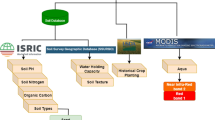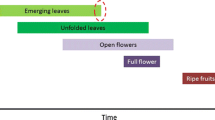Abstract
Monitoring vine water status is a major issue for vineyard management because water constraints impact both the quality and the quantity of the harvest. Existing methods are often costly and complex to implement. ApeX-Vigne is a free mobile application developed to facilitate the collection and geolocation of 50 vine apex observations to characterise vine shoot growth and classify it into 3 growth categories. The application also provides the user with a simple estimate of vine water status based on shoot growth. This paper presents the results obtained over two seasons (2019 and 2020) after the launch of the Apex-Vigne application and its use over a large wine producing region in the south of France. An existing method was adapted for evaluating the interest of the application based on the number of installations and uninstallations. The results showed that the application had more than 1200 downloads and 6000 observations made in the 2020 season. Examples from the commercially collected data showed that ApeX-Vigne can be used as a tool for characterizing water stress at within-field and inter-field scales. Finally, it was also demonstrated that by enabling the massive and centralized collection of spatial field and within-field scale observations of shoot growth, the ApeX-Vigne data was able to characterise the spatial structure of vine water status at the regional scale. Access to this new source of information offers opportunities for the management of water resources at a regional scale as well as for site- and vineyard-specific management. These results also raised new research questions on the joint use of this new source of spatial data with other sources of high spatial resolution information.









Similar content being viewed by others
Data availability
The data collected in this project is not available. Please contact the corresponding author to access the data.
Code availability
The code of the ApeX-Vigne application is available online at: https://github.com/Agrotic-Supagro/ApexV3.
References
Agreste, Recensement agricole (Census of Agriculture). (2010). [web] (consulted on 30/09/2020) https://www.agreste.agriculture.gouv.fr/
Baralon, K., Payan, J.-C., Salançon, E., & Tisseyre, B. (2012). SPIDER: spatial extrapolation of the vine water status at the whole denomination scale from a reference site. Journal International Des Sciences De La Vigne et Du Vin, 46(3), 167–175.
Ben Salem-Fnayou, A., Bouamama, B., & Wahed, A. (2011). Investigations on the leaf anatomy and ultrastructure of grapvine (Vitis vinifera) under heat stress. Microscopy Research and Technique, 74, 756–762.
Bota, J., Flexas, J., & Medrano, H. (2001). Genetic variability of photosynthesis and water use in Balearic Grapevine cultivars. Annals of Applied Biology, 138, 353–361.
Brunel, G., Pichon, L., Taylor, J. A., & Tisseyre, B. (2019). Easy water stress detection system for vineyard irrigation management. In: J. V. Stafford (Ed.) Precision Agriculture ’19: Proceedings of the 12th European Conference on Precision Agriculture, ECPA 2019, Wageningen, The Netherlands: Wageningen Academic Publishers. pp. 935–942
Cifre, J., Bota, J., Escalona, J. M., Medrano, H., & Flexas, J. (2005). Physiological tools for irrigation scheduling in grapevine (Vitis vinifera L.). An open gate to improve water-use efficiency? Agriculture, Ecosystems & Environment, 106, 159–170.
Dehnen-Schmutz, K., Foster, G. L., Owen, L., & Persello, S. (2016). Exploring the role of smartphone technology for citizen science in agriculture. Agronomy for Sustainable Development, 36, 25.
Deloire, A., Carbonneau, A., Wang, Z., & Ojeda, H. (2004). Vine and water a short review. Journal International Des Sciences de La Vigne et Du Vin, 38(1), 1–13.
Fogliaroni, P., D’Antonio, F., & Clementini, E. (2018). Data trustworthiness and user reputation as indicators of VGI quality. Geo-Spatial Information Science, 21(3), 213–233.
Goodchild, M. F., & Li, L. (2012). Assuring the Quality of Volunteered Geographic Information. Spatial Statistics, 1, 110–120.
Hunter, J.-J.K., Tarricone, L., Volschenk, C., Giacalone, C., Susete Melo, M., & Zorer, R. (2020). Grapevine Physiological Response to Row Orientation-Induced Spatial Radiation and Microclimate Changes. Oeno One, 54(2), 411–433.
INAO, Institut National de l’origine et de la qualité (National Institute of Origin and Quality) 2020 [web] (consulted on 16/07/2020) https://www.inao.gouv.fr/eng/
IGN, Institut national de l'information géographique et forestière (National Institute of Geographic and Forest Information) 2020 [web] (consulted on 16/07/2020) https://www.ign.fr/institut/identity-card
Joly, A., Bonnet, P., Goëau, H., Barbe, J., Selmi, S., Champ, J., et al. (2016). A Look inside the Pl@NtNet Experience. Multimedia Systems, 22(6), 751–766.
Kerry, R., & Oliver, M. A. (2007). Sampling requirements for variograms of soil properties computed by the method of moments and residual maximum likelihood. Geoderma, 140, 383–396.
Leibar, U., Unamunzaga, O., Fernández-Gómez, M. J., Galindo-Villardon, P., Castro, C., & Aizpurua, A. (2018). Benefit of ancillary data acquired at the cooperative level to study soil type and climatic zone influence on berry composition: A case study in Rioja Appellation. Oeno One, 52(2), 119–133.
Liu, X., Li, H., Lu, X., Xie, T., Mei, Q., Feng, F., et al. (2018). Understanding diverse usage patterns from large-scale appstore-service Profiles. IEEE Transactions on Software Engineering, 44(4), 384–411.
Martinez-De-Toda, F., Balda, P. and Oliveira, M. (2010). Estimation of Vineyard water status (Vitis Vinifera L. Cv. Tempranillo) from the developmental stage of the shoot tips. Journal International Des Sciences de La Vigne et Du Vin, 44(4), 201–6.
Météo France (French Institute of Meteorology and Climatology) 2020 [web] (consulted on 16/07/2020): https://meteofrance.com/
Michels, M., Fecke, W., Feil, J. H., Musshoff, O., Pigisch, J., & Krone, S. (2020). Smartphone adoption and use in agriculture: Empirical evidence from Germany. Precision Agriculture, 21, 403–425.
Minet, J., Curnel, Y., Gobin, A., Goffart, J. P., Mélard, F., Tychon, B., et al. (2017). Crowdsourcing for agricultural applications: A review of uses and opportunities for a farm sourcing approach. Computers and Electronics in Agriculture, 142(Part A), 126–138.
Mishra, U., Lal, R., Liu, D., & Van Meirvenne, M. (2010). Predicting the spatial variation of the soil organic carbon pool at a regional scale. Soil Science Society of America Journal, 74(3), 906–914.
Naulleau, A., Gary, C., Prévot, L., & Hossard, L. (2021). Evaluating strategies for adaptation to climate change in grapevine production—A systematic review. Frontiers in Plant Science, 11, 1–20.
Oliver, M. A., & Webster, R. (2015). Basic steps in geostatistics: The Variogram and Kriging (pp. 1–99). Cham, Switzerland: Springer International Publishing.
Parker, A. K., García De Cortázar-atauri, I., Trought, M. C. T., Destrac, A., & Agnew, R. (2020). Adaptation to climate change by determining grapevine cultivar differences using temperature-based phenology models. Oeno One, 54(4), 955–974.
Payan, J. C. (2020). Peut-on réduire la sensibilité au changement climatique sans irriguer ? (Can sensitivity to climate change be reduced without irrigation?). Entretiens de la vigne et du vin – Languedoc Roussillon 2020 - February 13th - Narbonne.
Pebesma, E. J. (2004). Multivariable geostatistics in S: the gstat package. Computers & Geosciences, 30, 683–691.
Pellegrino, A., Lebon, E., Simonneau, T., & Wery, J. (2005). Towards a simple indicator of water stress in grapevine (Vitis Vinifera L.) based on the differential sensitivities of vegetative growth components. Australian Journal of Grape and Wine Research, 11(3), 306–15.
Picaut, J., Fortin, N., Bocher, E., Petit, G., Aumond, P., & Guillaume, G. (2019). An open-science crowdsourcing approach for producing community noise maps using smartphones. Building and Environment, 148, 20–33.
QGIS Development Team (2020). QGIS Geographic Information System. Open Source Geospatial Foundation. URL http://qgis.osgeo.org
R Core Team (2020). R: A language and environment for statistical computing. R Foundation for Statistical Computing, Vienna, Austria. ISBN 3–900051–07–0, URL: http://www.R-project.org
Rahmati, A., & Zhong, L. (2013). Studying smartphone usage: Lessons from a four-month field study. IEEE Transactions on Mobile Computing, 12(7), 1417–1427.
Rey, D., & Neuhäuser, M. (2011). Wilcoxon-Signed-Rank Test. In M. Lovric (Ed.), International encyclopedia of statistical science. Berlin, Heidelberg, Germany: Springer.
Rienth, M., & Scholasch, T. (2019). State-of-the-art of tools and methods to assess vine water status. OENO One, 53(4), 619–637.
Rodriguez, L. B., Trambouze, W., & Jacquet, O. (2009). Évaluation de l´état de croissance végétative de la vigne par la méthode des apex (Evaluation of vine vegetative growth by the apex method). Progrès Agricole et Viticole, 126, 77–88.
Rogstadius, J., Vukovic, M., Teixeira, C.A., Kostakos, V., Karapanos, E., & Laredo, J. A. (2013). CrisisTracker: Crowdsourced social media curation for disaster awareness. IBM Journal of Research and Development, 57(5), 4:1–4:13.
Santesteban, L. G., Guillaume, S. B., Royo, J., & Tisseyre, B. (2012). Are precision agriculture tools and methods relevant at the whole-vineyard scale? Precision Agriculture, 14(1), 2–17.
Schultz, H. R. (2017). Issues to be considered for strategic adaptation to climate evolution is atmospheric evaporative demand changing ? Oeno One, 51(2), 107–114.
Senaratne, H., Mobasheri, A., Loai Ali, A., Capineri, C., & Haklay, M. (2016). A review of volunteered geographic information quality assessment methods. International Journal of Geographical Information Science, 31(1), 139–167.
Severinsen, J., de Roiste, M., Reitsma, F., & Hartato, E. (2019). VGTrust: Measuring trust for volunteered geographic information. International Journal of Geographical Information Science, 33(8), 1683–1701.
Taylor, J. A., Acevedo-Opazo, C., Pellegrino, A., Ojeda, H., & Tisseyre, B. (2011). A comment on inter-field spatial extrapolation of vine (Vitis vinifera L.) water status. Journal International Des Sciences De La Vigne et Du Vin, 45(2), 121–124.
Tisseyre, B., Ojeda, H., Carillo, N., Deis, L., & Heywang, M. (2005). Precision viticulture and water status, mapping the pre-dawn water potential to define within vineyard zones. In H. R. Shultz (Ed.), Proceedings of 14th GESCO congress, Geisenheim, Germany: Groupe d'Etudes des systèmes de Conduite de la Vigne, pp. 23–27.
Touya, G., Antoniou, V., Olteanu-Raimond, A. M., & Van Damme, M. D. (2017). Assessing Crowdsourced POI quality: Combining methods based on reference data, history, and spatial relations. ISPRS International Journal of Geo-Information, 6(3), 80.
Van Leeuwen, C., & Seguin, G. (1994). Incidences de l’alimentation en eau de la vigne, appréciée par l’état hydrique du feuillage, sur le développement de l’appareil végétatif et la maturation du raisin (Effects of the vine’s water supply, assessed by the water status of the foliage, on the development of the vegetative system and the ripening of the grapes). Journal International Des Sciences De La Vigne et Du Vin, 28(2), 81–110.
Van Leeuwen, C., Roby, J. P., & De Rességuier, L. (2018). Soil-Related Terroir Factors : A Review. Oeno One, 52(2), 173–188.
Vieira, S. R., Tillotson, P. M., Biggar, J. W., & Nielsen, D. R. (1997). Scaling of semivariograms and the kriging estimation of field-measured properties. Revista Brasileira de Ciência do Solo, 21, 525–533.
Willwerth, J.J. and Reynolds, A.G. (2020). Spatial variability in Ontario Riesling Vineyards : I . Soil , vine water status and vine performance. Oeno One, 54(2), 327–49.
Yzarra, W., Sanabria, J., Cáceres, H., Solis, O., & Lhomme, J. P. (2015). Impact of climate change on some grapevine varieties grown in Peru for Pisco production. Oeno One, 49(2), 103–112.
Zufferey, V., Spring, J-L., Verdenal, T., Dienes, A., Belcher, S., Lorenzini, F., et al. (2017). The influence of water stress on plant hydraulics, gas exchange, berry composition and quality of Pinot Noir wines in Switzerland. Oeno One, 51(1)
Acknowledgements
The authors would like to thank the “Institut Français de la Vigne et du Vin” for their involvement throughout the development of the application. We also thank the “Chambres d’Agriculture” who participated in the test during the 2018 season.
Funding
The Occitanie region financially supported this work in the framework of the crowd-viti project (repere project). The lead author’s PhD project is supported by the French National Research Agency under the Investments for the Future Program (ANR-16-CONV-0004).
Author information
Authors and Affiliations
Corresponding author
Ethics declarations
Conflict of interest
The authors declare that they have no conflict of interest.
Additional information
Publisher's Note
Springer Nature remains neutral with regard to jurisdictional claims in published maps and institutional affiliations.
Rights and permissions
About this article
Cite this article
Pichon, L., Brunel, G., Payan, J.C. et al. ApeX-Vigne: experiences in monitoring vine water status from within-field to regional scales using crowdsourcing data from a free mobile phone application. Precision Agric 22, 608–626 (2021). https://doi.org/10.1007/s11119-021-09797-9
Accepted:
Published:
Issue Date:
DOI: https://doi.org/10.1007/s11119-021-09797-9




